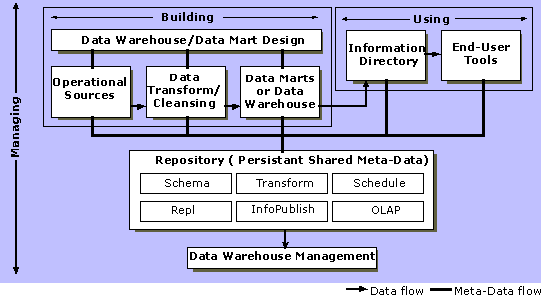
The goal of the Microsoft Data Warehousing Framework is to simplify the design, implementation, and management of data warehousing solutions. This framework has been designed to provide:
The Data Warehousing Framework has been designed from the ground up to provide an open architecture that can be extended easily by Microsoft customers and third-party businesses using industry-standard technology. This allows organizations to choose best-of-breed components and still be assured of integration.
Ease of use is a compelling reason for customers and independent software vendors (ISVs) to choose the Data Warehousing Framework. Microsoft provides an object-oriented set of components designed to manage information in the distributed environment. Microsoft also provides both entry-level and best-of-breed products to address the many steps in the data warehousing process.
Building the data warehouse requires a set of components for describing the logical and physical design of the data sources and their destinations in the enterprise data warehouse or data mart.
To conform to definitions laid out during the design stage, operational data must pass through a cleansing and transformation stage before being placed in the enterprise data warehouse or data mart. This data staging process can be many levels deep, especially with enterprise data warehousing architectures, but is necessarily simplified in this illustration.

End-user tools, including desktop productivity products, specialized analysis products, and custom programs, are used to gain access to information in the data warehouse. Ideally, user access is through a directory facility that enables end-user searches for appropriate and relevant data to resolve questions and that provides a layer of security between the end users and the data warehouse systems.
Finally, a variety of components can come into play for the management of the data warehousing environment, such as for scheduling repeated tasks and managing multiserver networks.
The Data Warehousing Framework describes the relationships between the various components used in the process of building, using, and managing a data warehouse. Two enabling technologies comprise the core Data Warehousing Framework: the integrated metadata repository and the data transport layer (OLE DB). These technologies make possible the interoperability of many products and components involved in data warehousing.
OLE DB provides for standardized, high-performance access to a wide variety of data, and allows for integration of multiple data types.
Microsoft Repository provides an integrated metadata repository that is shared by the various components used in the data warehousing process. Shared metadata allows for the transparent integration of multiple products from a variety of vendors, without the need for specialized interfaces between each of the products:
OLE DB defines a collection of COM interfaces that encapsulates various database management system services. These interfaces enable the creation of software components that implement such services. OLE DB components consist of data providers (which contain and expose data), data consumers (which use data), and service components (which process and transport data).
OLE DB interfaces are designed to integrate components smoothly so that vendors can bring high-quality OLE DB components to the market quickly. In addition, OLE DB includes a bridge to ODBC that enables continued support for the broad range of ODBC relational database drivers available today.